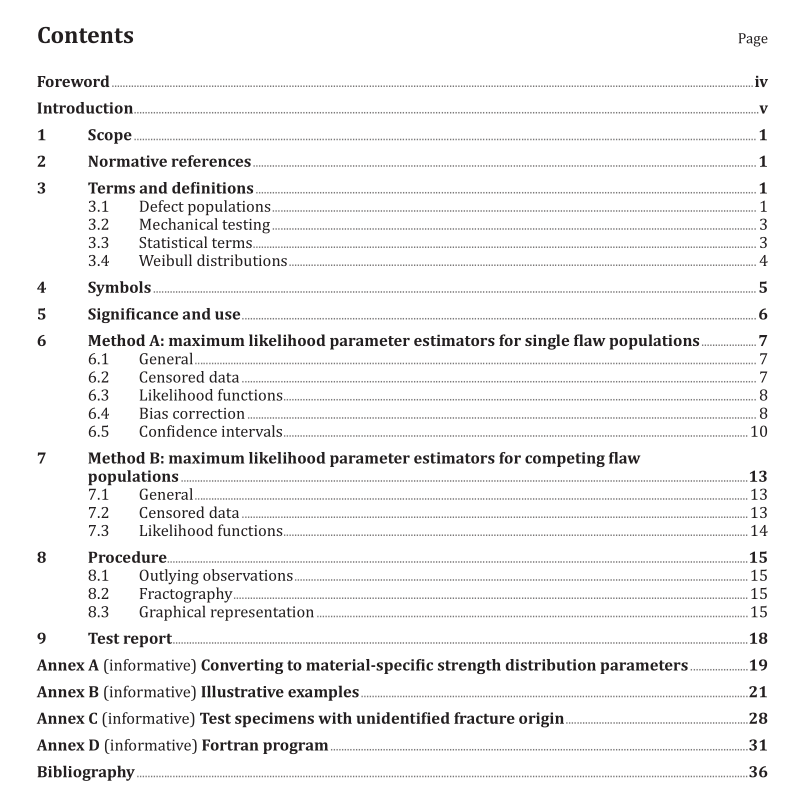ISO 20501 pdf download

ISO 20501 pdf download Fine ceramics (advanced ceramics, advanced technical ceramics) — Weibull statistics for strength data
1scope
This document covers the reporting of uniaxial strength data and the estimation of probabilitydistribution parameters for advanced ceramics which fail in a brittle fashion.The failure strength ofadvanced ceramics is treated as a continuous random variable. Typically, a number of test specimenswith well-defined geometry are brought to failure under well-defined isothermal loading conditions.The load at which each specimen fails is recorded. The resulting failure stresses are used to obtainparameter estimates associated with the underlying population distribution.
This document is restricted to the assumption that the distribution underlying the failure strengths isthe two-parameter Weibull distribution with size scaling.Furthermore, this document is restricted totest specimens (tensile, flexural, pressurized ring, etc.) that are primarily subjected to uniaxial stressstates. Subclauses 6.4 and 6.5 outline methods of correcting for bias errors in the estimated Weibullparameters, and to calculate confidence bounds on those estimates from data sets where all failuresoriginate from a single flaw population (i.e. a single failure mode).In samples where failures originatefrom multiple independent flaw populations (e.g.competing failure modes), the methods outlined in 6.4and 6.5 for bias correction and confidence bounds are not applicable.
2Normative references
There are no normative references in this document.
3Terms and definitions
For the purposes of this document, the following terms and definitions apply.
ISO and IEC maintain terminological databases for use in standardization at the following addresses:- ISo Online browsing platform: available at https://www.iso.org/obp
一IEC Electropedia: available at http://www.electropedia.org/
NOTE See also Reference [1].
3.1Defect populations3.1.1
flaw
inhomogeneity, discontinuity or (defect) feature in a material, which acts as stress concentrator due toa mechanical load and has therefore a certain risk of mechanical failure
Note 1 to entry: The flaw becomes critical if it acts as fracture origin in a failed specimen.
3.2Mechanical testing3.2.1
effective gauge section
that portion of the test specimen geometry included within the limits of integration (volume, area oredge length) of the Weibull distribution function
Note 1 to entry: ln tensile specimens, the integration may be restricted to the uniformly stressed central gaugesection, or it may be extended to include transition and shank regions.
3.2.2
fractography
analysis and characterization of patterns generated on the fracture surface of a test specimen
Note 1 to entry: Fractography can be used to determine the nature and location of the critical fracture origincausing catastrophic failure in an advanced ceramic test specimen or component.
3.3Statistical terms
3.3.1
confidence interval
interval within which one would expect to find the true population parameter
Note 1 to entry: Confidence intervals are functionally dependent on the type of estimator utilized and thesample size.The level of expectation is associated with a given confidence level. When confidence bounds arecompared to the parameter estimate one can quantify the uncertainty associated with a point estimate of apopulation parameter.
3.3.2
confidence level
probability that the true population parameter falls within a specified confidence interval3.3.3
estimator
function for calculating an estimate of a given quantity based on observed data
Note 1 to entry: The resulting value for a given sample may be an estimate of a distribution parameter (a pointestimate) associated with the underlying population, e.g.the arithmetic average of a sample is an estimator ofthe distribution mean.
3.3.4
population
collection of data or items under consideration3.3.5
probability density functionpdf
function f (x) for the continuous random variable X if









